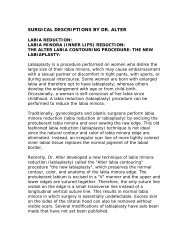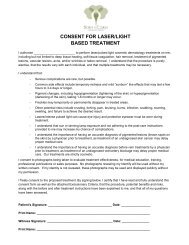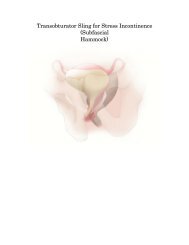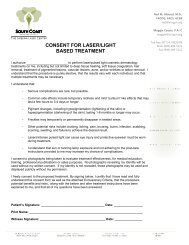Noninvasive vulvar lesions An illustrated guide to ... - Urogyn.org
Noninvasive vulvar lesions An illustrated guide to ... - Urogyn.org
Noninvasive vulvar lesions An illustrated guide to ... - Urogyn.org
You also want an ePaper? Increase the reach of your titles
YUMPU automatically turns print PDFs into web optimized ePapers that Google loves.
▲<strong>Noninvasive</strong> <strong>vulvar</strong> <strong>lesions</strong>: <strong>An</strong> <strong>illustrated</strong> <strong>guide</strong>FIGURE 6Paget disease: Not just a breast complaintPaget disease of the nipple withunderlying ductal adenocarcinoma.Vulvar Paget disease: lesion (left) and pho<strong>to</strong>micrograph of the lesion.FAST TRACKPaget’s diseaseof the vulva oftenrecurs, especiallywhen the initiallesion is largeago, simple vulvec<strong>to</strong>my was performed, butthe patient was left a sexual cripple.Since then, laser therapy has beenattempted in these cases, and has proved<strong>to</strong> be effective when the area treated doesnot exceed 25% of the <strong>to</strong>tal area of thevulva. Extensive laser therapy leads <strong>to</strong>considerable pos<strong>to</strong>perative pain and anunhappy result.Extensive involvementmay necessitatelaser treatment by quadrant <strong>to</strong> achievethe best results. <strong>An</strong>other option is “skinningvulvec<strong>to</strong>my” using a skin graft. Thisprocedure, first described by FelixRutledge, 11 requires a 7- or 8-day hospitalization,but allows for complete therapyin 1 session.❚ Paget’s disease of the vulvaThis disease is most frequently seen in thebreast nipple (FIGURE 6), where it is usuallyassociated with an underlying infiltratingductal carcinoma. Extramammary sitesinclude the <strong>vulvar</strong>, perianal, and axillaryregions. The disease has also been seen inthe ear canal.Paget’s disease is an intraepithelial adenocarcinomaof eccrine or apocrine origin.Clinical appearancePaget’s disease of the vulva appears as asuperficial, red <strong>to</strong> pink, velvety, eczema<strong>to</strong>idlesion (FIGURE 6), which is very pruritic andoften associated with exfoliation. Marginsare difficult <strong>to</strong> identify grossly.On rare occasions, a nodular tumorcan be found in the middle of the skininvolvement, but in most cases no invasivemalignancy is found at extramammarysites on the vulva.Diagnostic strategiesMicroscopic appearance of Paget cells(FIGURE 6) are pathognomonic of thedisease.Older textbooks suggest that 10% <strong>to</strong>20% of patients have an associated, underlying,invasive carcinoma of a skinappendage, Bartholin’s gland, urinarytract, or bowel or rectal site, but laterexperience has not confirmed this. Rather,the likelihood of concomitant invasive diseaseis much lower than 10%.Excision is the treatment of choice<strong>An</strong>y attempt <strong>to</strong> achieve negative marginsmust utilize frozen section. Some studieshave suggested that negative margins are notassociated with a reduced rate of recurrence,but these findings have been inconsistent.Recurrence is commonPaget’s disease of the vulva often recurs,especially when the initial lesion is large.Close moni<strong>to</strong>ring will detect these recurrenceswhen they’re quite small and easilyC ONTINUED76 OBG MANAGEMENT • December 2006
















